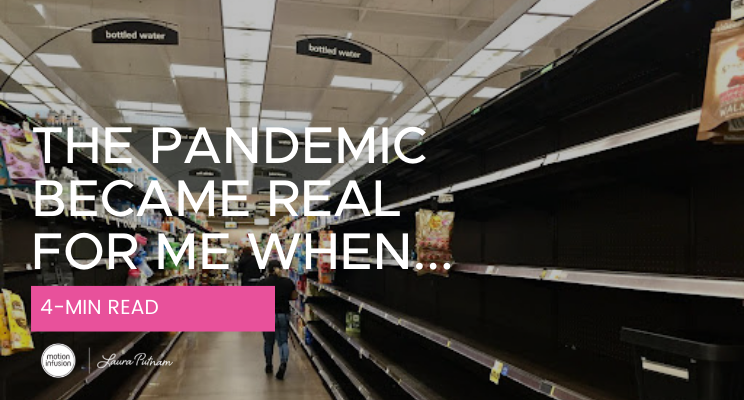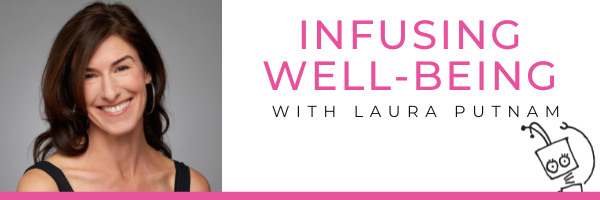|
March 9th, 2020. I was in Palm Springs, CA. Overnight, the shelves went from being stocked and “normal” to wiped clean. I recall how spooky it felt to be in a grocery store surrounded by bare aisles and an unmistakable feeling of panic as the world lurched into the unknown. When did the pandemic become real for you? Was it relatively mundane, like seeing shelves wiped clean of basic supplies? Or, was it much more significant, like losing a loved one or contracting long Covid? Each of us experienced a moment in which we crossed over from life-as-usual to world-turned-upside-down. What that moment looked like, of course, varied across a huge spectrum. Now, the world is ready to move on. Just go into any airport to see how quickly most have shed their masks following Judge Mizelle’s elimination of the nationwide public transit mask mandate at the end of last month. Unfortunately, though, as we’ve all heard, “While we may be done with the pandemic, the pandemic is not done with us.” The pandemic rages on. Just this past weekend, we hit the unthinkable threshold of over 1 million Americans lost to COVID. Alongside Covid, however, there are pandemics within the pandemic. These may be with us for years to come. What are they and how can we reckon with them? 1. Mental health The last two years have been incredibly stressful for everyone. In March, the World Health Organization reported that anxiety and depression had increased by 25% worldwide – and that was just during the first year of the pandemic. The effects of this wave of mental health issues is showing up in the workplace. Many have lost their job or have left their job or are working with reduced staff. So many made the shift from working in the office to working from home to now returning to a hybrid environment, often while caring for others. For many, working from home meant an awful lot of isolation. Rates of substance abuse and drug overdoses increased. Moreover, while rates of suicide went down during the pandemic, now they are ticking back up – especially for young people. There is a lot that is happening, and many employees are saying out loud: “I need help with my mental health.” Every organization needs to buckle up and tackle mental health head on. The days of “Check your emotions at the door” no longer hold. The days of leaders showing “strength” in lieu of vulnerability needs to be in the rear-view mirror. And, the time of managers viewing mental health as something that gets “referred out” is anachronistic. As a participant shared in a keynote that I delivered last week for Co-ACT, a Detroit-based organization that provides support for local nonprofits, “We need to acknowledge what we are all experiencing, which is ‘collective PTSD.’ So, let’s be flexible and let’s be compassionate with one another.” Yes, let’s. Each of us, regardless of our rank within the organization, need to step up to make the added effort to notice and connect with our coworkers. Are there any who are checking out? How might we extend ourselves a little bit more to awaken more compassion within our team? But, beyond these acts of empathy and compassion, organizations need to be willing to take an “outside-in” approach to better tackle mental health at work. Are there policies in place to ensure that workloads are sustainable? Is there a culture of toxicity and unfairness? If so, are leaders and managers openly discussing it, and taking measures to address it? Are there systems in place that allow employees to downshift and restore? 2. Diabetes A recent New York Times article summed it up: Covid and diabetes are “colliding in a public health train wreck.” The 34 million Americans, or 13% of all U.S. adults, who suffer from diabetes were arguably hit harder by Covid than any other group. “It’s hard to overstate just how devastating the pandemic has been for those with diabetes,” said Dr. Giuseppina Imperatore, who oversees diabetes management for the CDC. First of all, those with diabetes are more vulnerable to complications from a Covid infection and are much more likely to die. But the pandemic impacted even those who did not contract the virus. With hospitals and clinics overloaded, access to care decreased. Moreover, with sheltering in place, access to healthy food options diminished as did access to physical activity. Net result: unhealthy lifestyle behaviors dramatically increased. The rise in diabetes is not new, and in fact, a whopping 1 out of every 4 dollars spent on health care goes toward it. The pandemic further exacerbated it, accelerating its impact. 3. Privilege The pandemic laid bare the role of privilege, and just how much this played a role in how much (or how little) we each have been impacted. For example, Black Americans have been overrepresented in terms of infection and mortality rates. Nearly 98 out of every 100,000 Black Americans have died from COVID-19 - more than double that for Whites and Asian Americans. The pandemic also widened the gap between the haves and have nots, leaving a legacy of poverty for many and a bounty for a lucky minority. According to the World Bank, the global poverty rate has increased from 7.8 percent of the world’s population before the pandemic to 9.1 percent today. Meanwhile, companies like Zoom experienced exponential growth with an increase in earnings from $106 million in 2019 to $882 million in the last quarter of 2021. In a society that values individualism perhaps above all else, it is bound to view the pursuit of health and well-being as an individual pursuit. But if there is anything that we have learned from the pandemic it is that my health and well-being matters to you, and yours matters to me. There is no me without you. The only way forward is together. Hope lies in collective action. Moving forward, how might each of us, as individuals, teams and organizations, start thinking about Creating an Oasis of Well-Being? How might every leader create a sanctuary of well-being for all at their workplace, and how might every manager carve out a safe harbor in which psychological safety reigns and compassion is alive? wORKSHOP | MOTM PART 2: Safe HarborThis workshop provides managers with the extra tools they need to ensure that their team members are resilient, feel cared for, feel psychologically safe, and are able to engage in honest discussions as a team.
0 Comments
Leave a Reply. |
Follow laura on social:Website by Brand Genie
|
join laura's monthly newsletter
|




